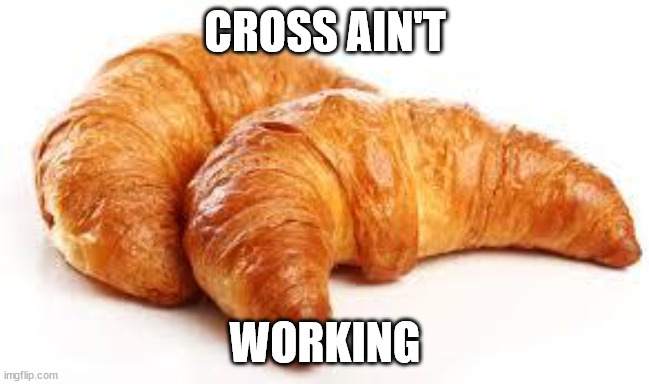And honestly, her flounce to BWP is so typical of what I saw for many years while being involved with warmblood inspections. Breeder gets miffed because their foal didn’t melt the inspectors’ hearts, so she flounces off to another registry. Breeder doesn’t understand and refuses to grasp that success of the registry’s brand (in a marketing sense) relies on the quality of horses it puts its stamp on. So when a registry doesn’t feel that the breeder’s foals measure up to those expectations, instead of changing her breeding program to better meet the registry’s expectations and help raise the quality of the breeding product - which helps increase the value of the “brand” - the breeder leaves in a huff and takes her business to a different registry - who will surely see the light and go all ga-ga about what the breeder is producing. 
And you have to realize when you take foals to be inspected the registry is breeding in a certain direction. As in - this is what we had to work with 60 years ago and this is where we want to be in 5 and 10 years. Different registries prefer different attributes. Jumping courses seem to be evolving in a certain direction (less scope and more technical) and we need this kind of horse to be on top of the podium and what we think will be successful in the future. So it’s not so much as they don’t like your horse - they just don’t think certain breeding decisions align with their vision of the future. Maybe they are wrong, after all it is their opinion. However they look at lots of foals and lots of performance horses being tested and get a much bigger picture than a small breeder. Not to mention they have been looking at horses for many, many years.
There are a lot of variables that you cannot tell about foals and they can change a lot. No reason to get in a snit if your breeding program is not being praised. Better to look at the comments, learn from them and put your horses into a performance career to see if you are going the right direction.
Thank you for this! I read it so many times and just figured it was a reference I didn’t understand.  Please let this become a new BB saying!
Please let this become a new BB saying!
I like croissants. 



Yes! That’s a hilarious autocorrect. And insult to delicious croissants everywhere 
Yes please! I’m seeing it as the COTH version of Dan Savage’s DTMFA.
This. A score in the 80s is exceptional. A mid-70s score is good. “First Premium” means “exceeds breed standard” and the majority of foals that are presented meet this — breeders aren’t likely to take foals they don’t think will get a first premium. A Second Premium is “meets breed standard,” or “KWPN isn’t embarrassed by it.” I’ve never seen one presented that didn’t at least get Second Premium, because if you produce something with major faults I’d imagine you hide it behind the barn and not present it to the inspectors, who are highly and systematically trained. The handlers are flown over from Holland too, and basically everyone pays them to present the foals. They are consummate professionals.
Every KWPN I have ever had has closely resembled the comments of the inspectors when grown. I have all their Keuring papers/comments and they are spot on. All were scored mid-70s and they are good, solid show horses who usually get 7.5s and 8s on gaits at USDF shows.
Excellent points!
Kate, no wonder they “have it out for you.” These are some really aggressive emails to people who provide a service and try to do it as genuinely as possible. This screams unprofessional.
[quote=“fordtraktor, post:5677, topic:789934”]
I’ve never seen one presented that didn’t at least get Second Premium, because if you produce something with major faults I’d imagine you hide it behind the barn and not present it to the inspectors, who are highly and systematically trained.[/quote]
My very first exposure to warmblood inspections was way back in the 80’s. (I think I had said late 70’s in an earlier post, but have now realized it was later than that.) I attended and assisted at a KWPN inspection, a Holsteiner inspection, and a Belgian Warmblood inspection, all held on consecutive days at a farm in this area. I actually saw a Third Premium handed out that day by KWPN. I didn’t know how rare Third Premiums were and the breeder was a novice - I think it was her first foal. It was sired by a European bred and approved GP dressage stallion and out of a successful UL dressage mare and it was super cute and a decent mover but it had pretty serious lordosis which is why it received a Third Premium. It makes me wonder how many other Third Premiums have been handed out through the years. My guess is not many…
 … Every time I think it’s got to be done and she’s going to finally stop engaging and walk away.
… Every time I think it’s got to be done and she’s going to finally stop engaging and walk away.
I don’t think Third Premium exists any longer. If you don’t get a 60 it fails and I believe they take its papers away? Not sure on that. Never seen one.
Actually that is not how it works in judging part breds
I just reread the messages posted by KS and have to laugh. She really cares what COTH has to say, not sure KWPN NA does.
I had some free time so just tried to look up info on BWP. Googling Belgian Warmblood, the first hit was for Belgian Warmblood - North American District (www.belgianwarmblood.com). Wow, does that website suck. It lists a lot of links to various sections and at first I thought the links weren’t going anywhere. But then I figured out that instead of jumping to another page or section, the linked info shows up at the bottom of that same screen - but you don’t know that unless you scroll all the way down. (Caveat - I am using a computer and not sure if the navigation is just as wonky on a mobile device.)
So the second item in the Google results was for Belgian Warmblood - BWP (belgian-warmblood.com). Navigation on that site is much better but I was unable to find some info.
After hunting around in both sites, it looks like a mare needs to be registered with a recognized studbook to be eligible for BWP Mare Book I (the main studbook). Recognized studbooks are most registries recognized by WBFSH, plus TB registries (I assume they mean JC-type registries), and Arabian registries.
As for foals, they must be sired by a BWP approved stallion and the dam must be entered into either the main or auxiliary studbook of BWP. One site says foals must be presented at a keuring to be eligible for registration, but also states that some foals may be eligible for registration without inspection (as determined by the Registrar). Foals that score 70 or above at a keuring are named Premium, foals scoring 75 or above are named First Premium.
So basically it sounds as though KS’s mares with KWPN papers (yes, even the ones with DHH dams), are eligible for breeding approval in the BWP main studbook, and the foals she is producing would be eligible for BWP registration if they are sired by BWP-approved stallions. I couldn’t easily determine if the stallions have to be officially approved (inspected, etc.) by BWP, or if the registry acknowledges stallion approval by other registries.
Also, the site for Belgian Warmblood - BWP (belgian-warmblood.com has some pages with a tab that says “Harness Horse” but that page only lists BWP “partners” (farms, businesses, etc.). There doesn’t seem to be any actual content about a Harness Horse book or breeding direction.
“Premium” seems an odd descriptor, considering. I dare say most people think of it as kind of a synonym of “elite”, used to describe something considerably above average. Top tier and then some. Summa cum laude.
Just my slightly random observation. It doesn’t make sense to apply the term to something that qualifies as just a step or two above “strictly average”.
But no one asked me. 
It’s a marketing gimmick. People can run around saying their foal was judged “premium” and buyers who don’t know the system won’t know to ask about scores, 1st premium vs. 2nd premium, etc.
In all fairness, the role of the registry is to support breeders in some respects. And… getting a foal inspected and registered theoretically helps breeders get a higher price for that foal. So in that sense, I guess the whole “everything is labeled premium” gimmick is fair game.
Oh well. Caveat emptor.
As a purchaser it does give you some idea of how the foal matches the breed standard.

